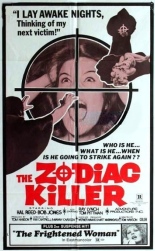
 David Fincher’s brilliant Zodiac suggested that the unsolved mystery of the San Francisco serial killings of the late 1960s and early ’70s could be penned on suspect Arthur Leigh Allen. Wrong! According to Tom Hanson’s The Zodiac Killer, the murderer was just that mailman named Jerry — you know, the hick one who lives with all those rabbits in his living room. Or maybe it’s Hanson who’s not to be trusted; his psycho-thriller is so inept, it plays as if Fincher were kicked in the head by a horse, and then let the horse write the screenplay.
David Fincher’s brilliant Zodiac suggested that the unsolved mystery of the San Francisco serial killings of the late 1960s and early ’70s could be penned on suspect Arthur Leigh Allen. Wrong! According to Tom Hanson’s The Zodiac Killer, the murderer was just that mailman named Jerry — you know, the hick one who lives with all those rabbits in his living room. Or maybe it’s Hanson who’s not to be trusted; his psycho-thriller is so inept, it plays as if Fincher were kicked in the head by a horse, and then let the horse write the screenplay.
And yet, San Francisco Chronicle reporter Paul Avery lends it credibility in opening titles that read in part, “If some of the scenes, dialogue, and letters seem strange and unreal, remember — they happened.”
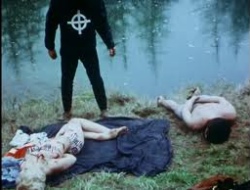 All of them? Really, Paul? Because then that would mean that, among other things, the Zodiac Killer:
All of them? Really, Paul? Because then that would mean that, among other things, the Zodiac Killer:
• wept uncontrollably over dead bunnies;
• was sexual dynamite to suntanning honeys on his route;
• was best buds with a truck-driving, divorced, fat baldie who fancied himself quite the catch (“Bitch, I told you a thousand times: Don’t touch my hair!”);
• set up a weenie roast on the beach to catch prey with delicious hot dogs: “I’m so very thrilled you like them. Stick around, it’ll get greater”;
• stalked MILFs at the playground, in broad daylight;
• offed a random teenage girl on a suburban street, in broad daylight;
• smashed an elderly woman’s noggin with her own spare tire, in broad daylight;
• pushed a rolling bed-ridden retirement-home resident down one of SF’s super-steep streets, in broad daylight;
• ambushed swimsuit-clad lovers with a friendly “I’m gonna have to stab you people!” in broad daylight;
• laughed when he called the police to report his own murders, in broad daylight; and
• eventually donned a black superhero-esque costume, complete with a draw-no-attention zodiac insignia on the chest, which he wore in broad daylight.
All those, Paul? Perhaps Avery — played by Robert Downey Jr. in Fincher’s 2007 film — made that statement while high on coke. But back to Hanson’s Zodiac Killer, whose narration includes an angry “Why? Why don’t you idiots ever learn?” He could be talking about Hanson and cast and crew. I, for one, am glad they didn’t learn a thing, because this flick is a hoot. —Rod Lott

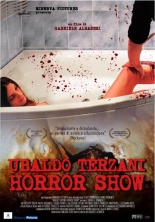
 At once a tribute to Italian horror of the 1980s — “the times of Lamberto Bava, when monsters and dolls squirted blood” — and a modern-day attempt to reinvent it,
At once a tribute to Italian horror of the 1980s — “the times of Lamberto Bava, when monsters and dolls squirted blood” — and a modern-day attempt to reinvent it, 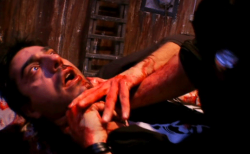
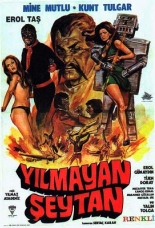
 Mere minutes after learning his long-dead father was the celebrated superhero Copperhead — a secret, despite the costume being left in the top of his adopted dad’s desk drawer — Tekin carries on the family tradition of fistfighting, leaping onto moving trains, and dressing in a sparkly silver mask and flowing red neckerchief. He leaves a novelty snake figurine at the scene of each skirmish, like a parting gift for kicking your ass.
Mere minutes after learning his long-dead father was the celebrated superhero Copperhead — a secret, despite the costume being left in the top of his adopted dad’s desk drawer — Tekin carries on the family tradition of fistfighting, leaping onto moving trains, and dressing in a sparkly silver mask and flowing red neckerchief. He leaves a novelty snake figurine at the scene of each skirmish, like a parting gift for kicking your ass. 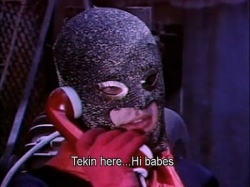
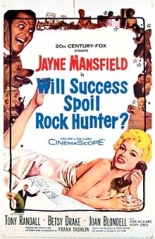
 With cinema attendance then taking a licking at the antennas of free TV, director Frank Tashlin literally stopped the story of his 1957 comedy,
With cinema attendance then taking a licking at the antennas of free TV, director Frank Tashlin literally stopped the story of his 1957 comedy, 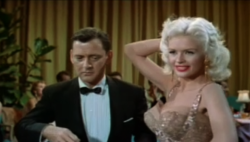
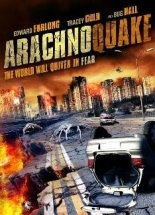
 As if New Orleans didn’t have enough problems already, what with the occasional hurricane, frat-boy vomit in the streets and the constant smell of hobo urine, the city has to deal with an arachnoquake — that is, an earthquake that unleashes giant spiders, doy! — in … wait for it … Arachnoquake. It’s one of those made-for-Syfy movies, but you probably knew that.
As if New Orleans didn’t have enough problems already, what with the occasional hurricane, frat-boy vomit in the streets and the constant smell of hobo urine, the city has to deal with an arachnoquake — that is, an earthquake that unleashes giant spiders, doy! — in … wait for it … Arachnoquake. It’s one of those made-for-Syfy movies, but you probably knew that. 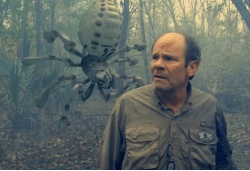 Spiders are so creepy that the concept doesn’t require a big budget to exploit audiences’ readymade fear. (Take, for instance, 1977’s
Spiders are so creepy that the concept doesn’t require a big budget to exploit audiences’ readymade fear. (Take, for instance, 1977’s